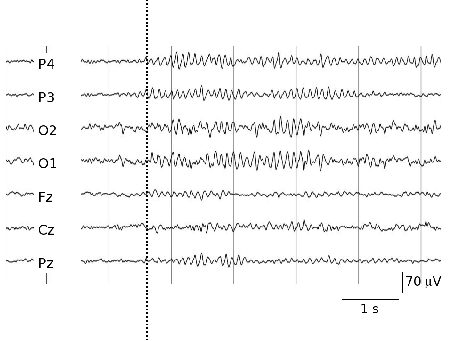Although the EEG is almost over 100-years old, the processes that are ultimately responsible for the rhythms that can be recorded on the brain surface of skull are only partially understood. Part of the research focuses on elementary issues related to EEG generation and interpretation.[1,2]

Part of an EEG. The subject closes his eyes at the dotted line, resulting in the emergence of the alpha rhythm.
Monitoring of Brain Function of high-risk patients in the Intensive Care Unit (ICU) is still limited. Although the EEG is a potentially very useful technique for real-time monitoring, at present this is not routine use in the ICU. Limitations include mounting time and the visual burden for the interpretation. An example of a visual transform is shown in the figure below.[2]

The Colorful Brain: A visual transform of the EEG.
Several of these techniques are currently implemented in our ICU for further clinical evaluation. Ischaemie in the operating room (OR) may occur during carotid surgery. A few years ago, the Brain Symmetry Index (BSI) was proposed to assist in the decision to shunt or not to shunt in carotid endarterectomy.[3,4] In the meantime, this index has proven very relevant for monitoring stroke patients, as well. [5]
- M.J.A.M. Van Putten and C.J. Stam, Application of a neural complexity measure to multichannel EEG, Phys Letters A 281(2-3): 131-141, 2001
- M.J.A.M. van Putten, The colorful brain: Visualization of EEG background patterns, J Clin Neurophysiol, 25(2):63-68, 2008.
- M.J.A.M. van Putten, J.M. Peters, S.M. Mulder, J.A.M. de Haas, C.M.A. Bruijninckx and D.L.J. Tavy, A brain symmetry index (BSI) for online EEG monitoring in carotid endarterectomy, J Clin Neurophysiol 115(5): 1189-1194, 2004.
- M.J.A.M. van Putten, The revised Brain Symmetry Index, J Clin Neurophysiol 118(11): 2362-2367, 2007.
- M.J.A.M. van Putten and D.L.J. Tavy, Continuous quantitative EEG monitoring in hemispheric stroke patients using the Brain Symmetry Index, Stroke 35(11): 2489-2492, 2004.
